
Plos Biology | Single-cell multiomics analyses of spindle-transferred human embryos suggest a mostly normal embryonic development
On August 16th, 2022, Tang Lab from Biomedical Pioneering Innovation Center (BIOPIC), Beijing Advanced Innovation Center for Genomics (ICG) collaborating with Wei Shang’s team from Chinese PLA General Hospital, published a paper titled Single-cell multiomics analyses of spindle-transferred human embryos suggest a mostly normal embryonic development on Plos Biology , which systematically evaluated the spindle-transferred human embryos from the transcriptome, DNA methylome, and genome (copy number variation).
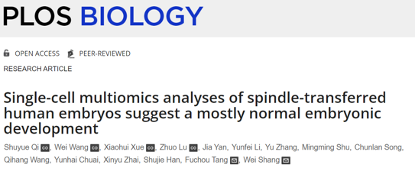
Mitochondrial DNA (mtDNA) mutations often lead to debilitating and devastating inherited metabolic diseases. And these are a kind of incurable disease, with 1 in 5,000 being the minimum prevalence rate for mtDNA mutations in adults. The mitochondrial genome is invariably maternal inheritance, and at least 1 in 200 offspring of female carriers carry an mtDNA mutation that potentially causes a disease. Conventional prenatal and preimplantation genetic diagnoses are only appropriate for women who can produce oocytes with a low enough percentage of mutant mtDNAs. However, no reproductive option is available for other female carriers. Clinicians have developed spindle transfer (ST) to prevent the transmission of mtDNA disease through the germline. Spindle transfer uncouples the inheritance of mtDNA from that of the nuclear genome through transferring the spindle complex of the oocyte at metaphase Ⅱ of meiosis of a woman with mutant mtDNA into an enucleated oocyte to form a reconstructed oocyte. Previous studies have demonstrated the effectiveness of spindle transfer in model organisms and human preimplantation embryos (residual fraction of original mtDNA<1%). And in 2016, Zhang and his colleagues used spindle transfer to deliver a live boy in Mexico whose mother’s mitochondria carried the mutation causing Leigh syndrome. But to date, no well-established studies have critically assessed the safety of this technique. It remains to be determined whether ST manipulation of oocytes affects gene expression or epigenome, and whether it causes abnormal embryonic development.
To systematically evaluate the effects of spindle transfer on human embryonic development, and to determine whether it is worthy of clinical translation, high-precision single-cell multi-omics sequencing (Trio-seq2) was performed on 23 human blastocysts constructed by ST and 23 human blastocysts (control embryos) only treated with intracytoplasmic sperm injection (ICSI). The transcriptome, DNA methylome, and genome (copy number variation) were analyzed to study the development characteristics of spindle-transferred human embryos at the blastocyst stage.
The three lineages of spindle-transferred blastocysts have very similar gene expression patterns to the corresponding lineage cells of control blastocysts.
First, the collected embryonic cells were identified as epiblast (EPI), primitive endoderm (PE), and trophectoderm (TE) lineages according to the canonical markers. Regression analysis showed that ST and ICSI control blastocysts were highly similar between the corresponding lineages, with high correlation coefficients (R2>0.9). Random down-sampling analysis suggested R2 was positively correlated with the sample number, which means the small sample size rather than significant variation within the group was the cause of the lower R2 value for PE. There were no more than 24 differentially expressed genes in the three lineages (24/7683="0.31%" of the total number of detected genes), suggesting the pattern of gene expression was nearly identical between the ST and control embryos (Figure 1). Additionally, t-SNE and hierarchical clustering analysis of gene expression and transcriptional regulatory network showed that cells were divided into three lineages, while the cells of the two groups still clustered together. These suggested that the gene expression patterns of the three lineages of ST embryos were consistent with those of the ICSI control embryos without obvious abnormalities.
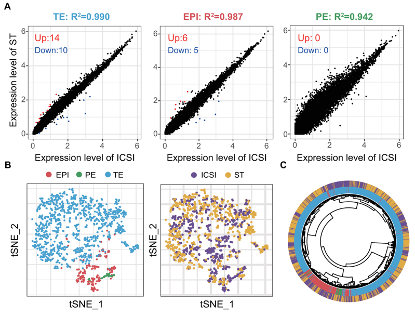
Figure 1 Comparative analysis of transcriptome between spindle-transferred blastocysts and ICSI control blastocysts.
Further, the study inferred the sex of each embryo based on the expression level of sex-linked genes and found that the imbalanced sex ratio was a confounding factor in the analysis of differentially expressed genes (Figure 2). A comparison of the expression levels of identified differentially expressed sex-linked genes in the embryos of the same gender between the ST and control group showed that XIST , VCX2 , VCX3B , EIF1AY , RPS4Y1 , and DDX3Y were no significant difference in expression (p>0.05 with Bonferroni correction or fold change<2).
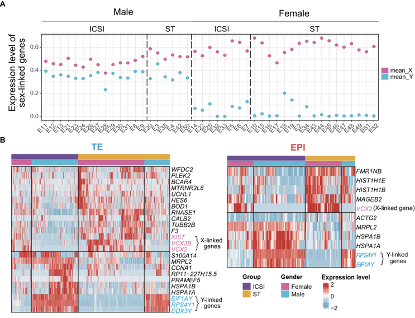
Figure 2 Sex inference and differentially expressed sex-linked gene analysis of spindle-transferred blastocysts and ICSI control blastocysts.
Trophectoderm cells of spindle-transferred blastocysts showed a slightly delayed global DNA demethylation process.
The study showed that ST blastocysts and slightly higher DNA methylation levels than controls and these hypermethylated regions were mainly enriched in repetitive elements. And the genomic methylation level of EPI and PE cells of ST blastocysts was similar to that of the control group, only the genomic DNA methylation level of TE cells was slightly higher than the control (2.4%). Since human embryos undergo a drastic global DNA demethylation process during preimplantation development, it is reasonable to speculate that the DNA demethylation process is slightly delayed in ST blastocysts. The pseudotime trajectory was constructed using the previously published DNA methylome data of human preimplantation embryos. The DNA methylation patterns of ST blastocysts were closer to those of the earlier preimplantation developmental stage, confirming the previous hypothesis (Figure 3). It is quite possible that after the blastocyst stage, ST embryos can “catch up” to complete the DNA demethylation process before implantation. Besides, the delay in DNA demethylation was a general trend in ST blastocysts and was not caused by abnormally high DNA methylation level of a small fraction of the embryos or a small fraction of the cells.
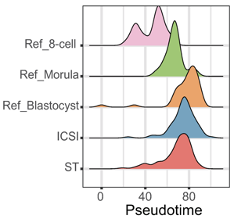
Figure 3 The Pseudotime trajectory analysis of DNA methylation in spindle-transferred blastocysts and ICSI control blastocysts.
Spindle transfer did not disturb the integrity and stability of the genome.
As for the genome (copy number variation) analysis, the results showed that the frequency of aneuploid cells of ST blastocysts increased compared with control blastocysts (22.7% versus 17%), but it was not statistically significant (p="0.99)." The regions of copy number variation were scattered, not clustered (Figure 4). Thus, the study showed that spindle transfer did not significantly increase the frequency of copy number variation in embryos.
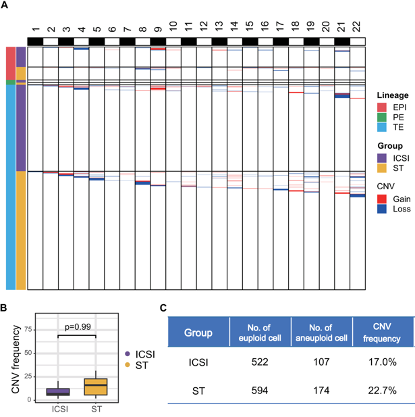
Figure 4 Copy number variation analysis of spindle-transferred blastocysts and ICSI control blastocysts.
Multiomics analysis revealed that the embryonic development patterns of spindle-transferred blastocysts were consistent with those of control blastocysts.
Finally, this study integrated the omics and found that there was a positive relationship between gene expression and copy number variation. And the integrated analysis of transcriptome and DNA methylome by multiple omics factor analysis deduced a set of hidden factors. The K-means clustering analysis based on factor1 and factor2 (or factor1 and factor5) and UMAP clustering analysis based on all the factors could divide the cells into three lineages, but the cells of ST and ICSI control blastocysts were tightly clustered together. These indicated the spindle-transferred blastocysts were highly similar with control blastocysts at multiple omics levels.
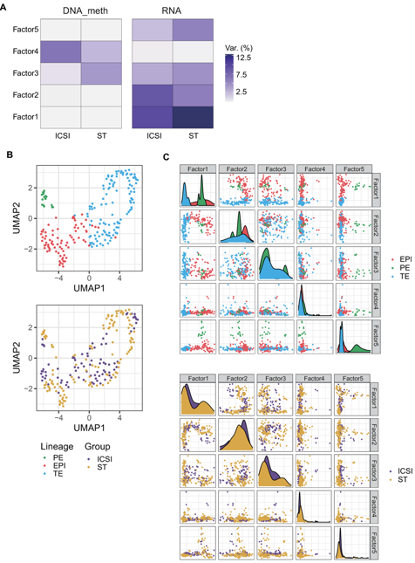
Figure 5 Integrative analysis of transcriptome and DNA methylome.
Collectively, this study provided the first systematic multi-omics analysis of the ST technique in single-cell resolution. This study evaluated the effects of ST on human embryonic development from the transcriptome, DNA methylome, and genome (copy number variation), and suggested that ST seems generally safe for human preimplantation embryos, with a relatively minor delay in the DNA demethylation process at the blastocyst stage. This study would promote further studies on the safety and effectiveness of assisted reproductive technology in blocking the germline transmission of mutant mtDNA-related diseases, and has reference value for promoting the clinical transformation of this technique.
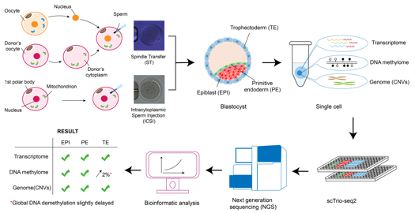
Figure 6 Research framework and main findings.
Ph.D. students Shuyue Qi and Xiaohui Xue from Peking University, Dr. Wei Wang from Chinese PLA General Hospital, as well as Zhuo Lu from New Hope Fertility Center, are the co-first authors of the paper. Professor Fuchou Tang from Peking University and Professor Wei Shang from Chinese PLA General Hospital are corresponding authors. This research was supported by grants from the National Key R&D Program of China and the Beijing Advanced Innovation Center for Genomics.
Link: https://doi.org/10.1371/journal.pbio.3001741